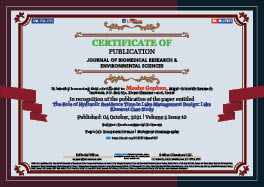> Environmental Sciences. 2021 October 04;2(10):888-889. doi: 10.37871/jbres1327.
The Role of Hydraulic Residence Time in Lake Management Design: Lake Kinneret Case Study
Moshe Gophen*
Lake Kinneret, is the only natural freshwater lake in Israel. It is a warm monomictic lake located below Sea level in the Syrian -African great rift valley in northern Israel. Kinneret is a multipurpose utilized body of water for water supply, fishery tourism and recreation. The impact of Residence Time (RT) length fluctuation on water quality was documented. Moreover, changes of climate conditions were indicated as stressors which change Hydraulic features and consequently the length of RT as well as water quality.
Hydraulic Residence Time (HRT) is a well-known factor in Limnological sciences. It is somewhat different from Chemical (nutrients) Retention Time (CRT). The HRT has an impact on the CRT but without opposite direction of ecological impact. Within the chemical substances (nutrients) there is difference between conservative and non-conservative substances. The factors influencing these differences are chemical, physical or biological processes. Nevertheless, ecological impact of HRT in natural ecosystems affecting entirely the whole ecosystem. The topic of the present document is HRT. The essence of HRT is simple and easily calculated: Theoretical time duration required to accomplish a full water exchange in a body of water (pond, lake, reservoir, etc.) calculated by dividing its total volume by the rate of water input (water volume per time unit). It is crudely demonstrated through several of Lake Kinneret Hydrological parameters shown in table 1, in respect to abnormal climate conditions resulted exceptional hydraulic parameter.
| Table 1: Lake Kinneret Hydrological parameters. | ||||
| Year | Annual Mean WL (mbsl) | Annual Water Input (mcm/y) | Annual Mean Lake Volume (mcm) | RT (years) |
| 1969 | 208.87 | 1099 | 4471 | 4.1 |
| 1992 | 209.32 | 842 | 4302 | 5.1 |
| 2001 | 214.11 | 254 | 3484 | 13.7 |
| 2015 | 212.45 | 141 | 3822 | 27.1 |
| 2019 | 211.54 | 160 | 3986 | 24.9 |
| WL: Water Level; mbsl: Meter Below Sea Level (Lake Kinneret Altitude location is below sea level); mcm: million cubic meters (106 m3); mcm/y: million cubic meter per year; Mean WL was calculated as the average between Highest and Lowes recorded WL; RT (years): Residence Time given in Years. | ||||
It should be considered that HRT might be prolonged when WL is high if discharge is low; HRT is defined not solely by discharge or Lake Volume (WL) but as the relation between them; It is possible that HRT become shorter when WL is low (low lake volume) if rate of discharge is high. Moreover, shortening of HRT under high WL might be enhanced by lake water release (open dam) or pumping withdraw. Due to the unique ecological position of the very common conservative Chloride ion (salinity, NaCl) it will be the representative parameter for the study of HRT evaluation impact.
Since the Mid 1980’s changes of climate conditions in the Watershed of Lake Kinneret were documented: precipitations and river discharges decline, and temperature elevation. Further modifications of nutrient inputs enhanced change of phytoplankton community structure. Outburst of Bleak fishes and the onset and offset of vegetation on beaches are also attributed to change in climate conditions. Climate condition fluctuated as an alternate between dryness and heavy precipitation. During 1969 the Dam was fully open whilst during 1992 fully closed, therefore same water input of app. 1 billion m3 during winter months the 1992’s RT was longer. Moreover, during 1969, (open dam) and 1992 (close dam) salinity (as Chloride) declined by 49 (300 to 251) and 39 (250-216) ppm during 1969 and 1992 respectively.
Chloride is a conservative ion which is not affected by internal biological factors and the impact of internal physical and chemical on its concentration fluctuations is probably negligible. The long record (1948-2020) of salinity (as Chloride concentration) in Lake Kinneret indicates major elevation periods during 1948-1968, 1988-1991, 1995-2003, 2005-2010 and 2014-2019 [1,2]. Whilst decline was recorded during 1964-1988, 1992 and 2003. There are no water input data prior to the 1960’s therefore RT computation was done just later. Nevertheless, it is suggested that increase of salinity between 1948-1964 is due to not fully open Dam policy which resulted upward trend of the WL and consequently RT prolongation and increase of salinity. The long period of Salinity decline causation is the diversion management of salinity springs: Ein Nur 1 & 2 annual discharge of 20×106 m3 with 2000 ppm Chloride (total load app. 40,000 tons). It is suggested that later on changes of salty are mostly affected by water balance resulting RT fluctuations (Table 2).
| Table 2: Water balance resulting RT fluctuations. | ||||
| Period | Mean Lake Volume (mcm) (106 m3) |
Annual Mean of water input (Jordan River) (mcm/y) | RT (years) | Periodical WL amplitude (mbsl) |
| 1988-1991 | 4217 | 358 | 11.8 | 210.40 - 208.89 |
| 1995-2003 | 4059 | 338 | 12 | 211.06 - 209.72 |
| 2005-2010 | 3823 | 381 | 10 | 210.86 - 212.66 |
| 2014-2019 | 3660 | 235 | 15.6 | 212.84 - 213.36 |
Results given in table 2 indicates the irrespective relation of RT length and WL (i.e. Lake Volume) but corelated to water balance.
References
- Gophen M. Relation Significance between Hydrological Residence Time and Phytoplankton Dynamics in Lake Kinneret (Israel). Open Journal of Ecology. 2019;9:479-492. https://bit.ly/3a3j6zF
- Gophen M. Lake Kinneret (Israel), Dam Open Management Dilemma: A commentary Review. Japan J Res. 2020;1:1-5.
Content Alerts
SignUp to our
Content alerts.
 This work is licensed under a Creative Commons Attribution 4.0 International License.
This work is licensed under a Creative Commons Attribution 4.0 International License.








